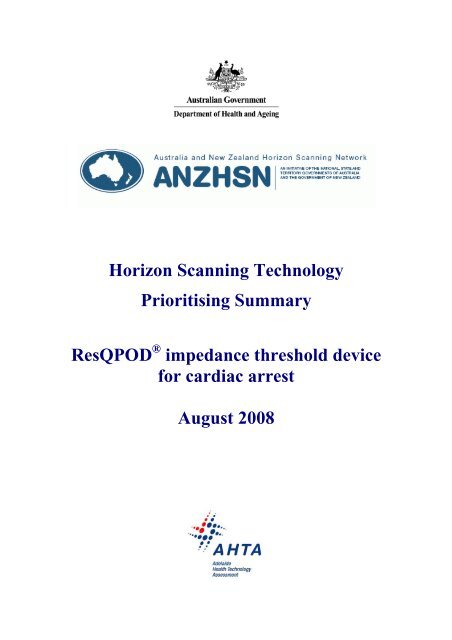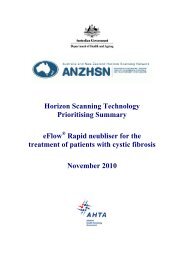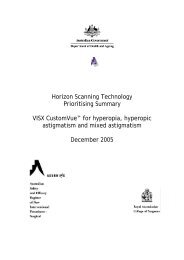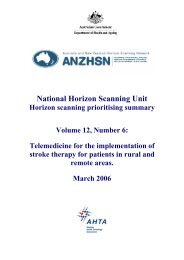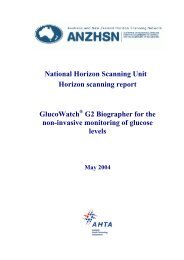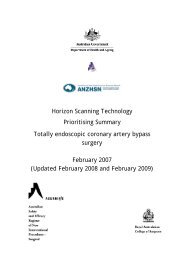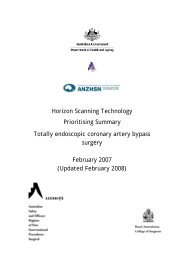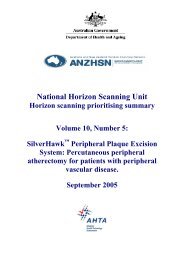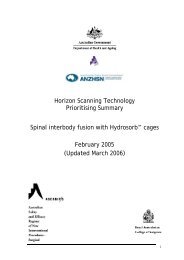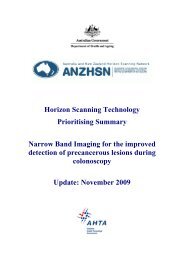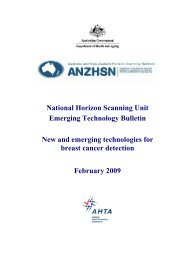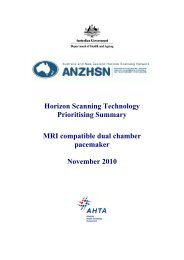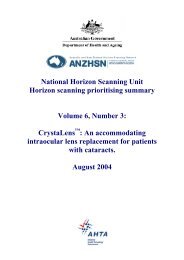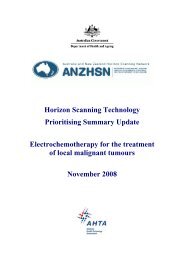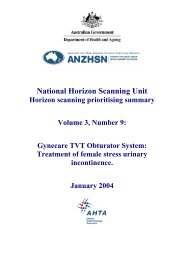ResQPOD impedance threshhold device - the Australia and New ...
ResQPOD impedance threshhold device - the Australia and New ...
ResQPOD impedance threshhold device - the Australia and New ...
You also want an ePaper? Increase the reach of your titles
YUMPU automatically turns print PDFs into web optimized ePapers that Google loves.
Horizon Scanning Technology<br />
Prioritising Summary<br />
<strong>ResQPOD</strong> ® <strong>impedance</strong> threshold <strong>device</strong><br />
for cardiac arrest<br />
August 2008
© Commonwealth of <strong>Australia</strong> 2008<br />
ISBN<br />
Publications Approval Number:<br />
This work is copyright. You may download, display, print <strong>and</strong> reproduce this material in<br />
unaltered form only (retaining this notice) for your personal, non-commercial use or use<br />
within your organisation. Apart from any use as permitted under <strong>the</strong> Copyright Act 1968, all<br />
o<strong>the</strong>r rights are reserved. Requests <strong>and</strong> inquiries concerning reproduction <strong>and</strong> rights should be<br />
addressed to Commonwealth Copyright Administration, Attorney General’s Department,<br />
Robert Garran Offices, National Circuit, Canberra ACT 2600 or posted at<br />
http://www.ag.gov.au/cca<br />
Electronic copies can be obtained from http://www.horizonscanning.gov.au<br />
Enquiries about <strong>the</strong> content of <strong>the</strong> report should be directed to:<br />
HealthPACT Secretariat<br />
Department of Health <strong>and</strong> Ageing<br />
MDP 106<br />
GPO Box 9848<br />
Canberra ACT 2606<br />
AUSTRALIA<br />
DISCLAIMER: This report is based on information available at <strong>the</strong> time of research cannot<br />
be expected to cover any developments arising from subsequent improvements health<br />
technologies. This report is based on a limited literature search <strong>and</strong> is not a definitive<br />
statement on <strong>the</strong> safety, effectiveness or cost-effectiveness of <strong>the</strong> health technology covered.<br />
The Commonwealth does not guarantee <strong>the</strong> accuracy, currency or completeness of <strong>the</strong><br />
information in this report. This report is not intended to be used as medical advice <strong>and</strong><br />
intended to be used to diagnose, treat, cure or prevent any disease, nor should it be used<br />
<strong>the</strong>rapeutic purposes or as a substitute for a health professional's advice. The Commonwealth<br />
does not accept any liability for any injury, loss or damage incurred by use of or reliance <strong>the</strong><br />
information.<br />
The production of this Horizon scanning prioritising summary was overseen by <strong>the</strong> Health<br />
Policy Advisory Committee on Technology (HealthPACT), a sub-committee of <strong>the</strong> Medical<br />
Services Advisory Committee (MSAC). HealthPACT comprises representatives from<br />
departments in all states <strong>and</strong> territories, <strong>the</strong> <strong>Australia</strong> <strong>and</strong> <strong>New</strong> Zeal<strong>and</strong> governments; <strong>and</strong><br />
ASERNIP-S. The <strong>Australia</strong>n Health Ministers’ Advisory Council (AHMAC) supports<br />
HealthPACT through funding.<br />
This Horizon scanning prioritising summary was prepared by Adrian Purins, Linda Mundy<br />
<strong>and</strong> Professor Janet Hiller from <strong>the</strong> National Horizon Scanning Unit, Adelaide Health<br />
Technology Assessment, Discipline of Public Health, School of Population Health <strong>and</strong><br />
Clinical Practice, Mail Drop 545, University of Adelaide, Adelaide, SA, 5005.
REGISTER ID: 000393<br />
PRIORITISING SUMMARY<br />
NAME OF TECHNOLOGY:<br />
PURPOSE AND TARGET GROUP:<br />
RESQPOD ® IMPEDANCE THRESHOLD DEVICE<br />
USED TO PROVIDE NEGATIVE THORACIC<br />
PRESSURE DURING CARDIOPULMONARY<br />
RESUSITATION (CPR) ON CARDIAC ARREST<br />
PATIENTS, IMPROVING PERFUSION.<br />
STAGE OF DEVELOPMENT (IN AUSTRALIA):<br />
Yet to emerge Established<br />
Experimental Established but changed<br />
indication or modification of<br />
technique<br />
Investigational Should be taken out of use<br />
Nearly established<br />
AUSTRALIAN THERAPEUTIC GOODS ADMINISTRATION APPROVAL<br />
Yes ARTG number<br />
No<br />
Not applicable<br />
The <strong>ResQPOD</strong> ® was registered on <strong>the</strong> TGA as a Class I <strong>device</strong>. This registration has<br />
lapsed <strong>and</strong> First Response <strong>Australia</strong> is currently seeking to have <strong>the</strong> <strong>device</strong> registered<br />
as a Class II <strong>device</strong> (personal communication First Response <strong>Australia</strong>).<br />
INTERNATIONAL UTILISATION:<br />
USA<br />
France<br />
Germany<br />
UK<br />
COUNTRY<br />
Trials Underway<br />
or Completed<br />
<br />
<br />
<br />
LEVEL OF USE<br />
Limited Use<br />
<br />
Widely Diffused<br />
IMPACT SUMMARY:<br />
Advanced Circulatory Systems Inc (United States) markets <strong>the</strong> <strong>ResQPOD</strong> ® , which is<br />
distributed in <strong>Australia</strong> by First Response <strong>Australia</strong>. The <strong>ResQPOD</strong> ® is an <strong>impedance</strong><br />
threshold <strong>device</strong> for use during cardiopulmonary resuscitation (CPR) performed on<br />
patients who are having a cardiac arrest. The <strong>ResQPOD</strong> ® would be used by<br />
emergency medical services staff during routine resuscitation attempts.<br />
<strong>ResQPOD</strong> ® <strong>impedance</strong> threshold <strong>device</strong> for cardiac arrest: August 2008 1
BACKGROUND<br />
Cardiac arrest is a leading cause of death in <strong>Australia</strong> <strong>and</strong> CPR is used to resuscitate<br />
<strong>the</strong>se patients. CPR chest compressions are designed to force blood out of <strong>the</strong> heart<br />
during <strong>the</strong> compression phase <strong>and</strong> negative pressure in <strong>the</strong> chest cavity during <strong>the</strong><br />
recoil phase facilitates <strong>the</strong> flow of blood back into <strong>the</strong> heart ready for <strong>the</strong> next<br />
compression. In normal CPR <strong>the</strong> influx of air into <strong>the</strong> lungs lessens <strong>the</strong> intra-thoracic<br />
vacuum reducing <strong>the</strong> blood flow backing to <strong>the</strong> heart. The <strong>ResQPOD</strong> ® is designed to<br />
transiently impede <strong>the</strong> flow of air into <strong>the</strong> lungs during chest wall recoil, maintaining<br />
<strong>the</strong> intra-thoracic negative pressure. This should facilitate greater blood flow back to<br />
<strong>the</strong> heart allowing a higher rate of blood flow to occur during compression. The<br />
<strong>ResQPOD</strong> ® <strong>device</strong> is a small <strong>device</strong> with pressure sensors <strong>and</strong> valves that can be<br />
attached to an endotracheal tube or a facemask (Figure 1). The <strong>device</strong> does not<br />
impede normal exhalation <strong>and</strong> can be used in conjunction with <strong>the</strong> normal ventilation<br />
of <strong>the</strong> patient. In addition, <strong>the</strong> <strong>device</strong> has lights which can assist <strong>the</strong> timing of<br />
compressions.<br />
Figure 1 The <strong>ResQPOD</strong> ® attached to a face mask <strong>and</strong> ventilator bag (First Response <strong>Australia</strong> 2007)<br />
Figure 2 <strong>ResQPOD</strong> features (First Response <strong>Australia</strong> 2007)<br />
<strong>ResQPOD</strong> ® <strong>impedance</strong> threshold <strong>device</strong> for cardiac arrest: August 2008 2
CLINICAL NEED AND BURDEN OF DISEASE<br />
The causes of cardiac arrest are diverse, including cardiovascular disease,<br />
electrophysiological abnormalities, toxins <strong>and</strong> shock. A study conducted in Victoria<br />
by Jennings et al (2006) reported an out of hospital cardiac arrest survival rate of 7.4<br />
<strong>and</strong> 1.9 per cent in urban <strong>and</strong> rural areas, respectively. Ano<strong>the</strong>r larger Victorian study<br />
in 2002-2005 found <strong>the</strong> survival rate of 18, 827 out-of-hospital cardiac arrests to be<br />
3.8 per cent (Fridman et al 2007). When extrapolated to <strong>the</strong> <strong>Australia</strong>n population of<br />
2004 (20.1 million at June 2004 (ABS 2006)) out-of-hospital cardiac arrests are<br />
responsible for an estimated 18,000 deaths per year. Although <strong>the</strong> underlying cause of<br />
cardiac arrest can be diverse, a major attributable factor is cardiovascular disease. A<br />
need exists for better treatment of cardiac arrest to increase <strong>the</strong> survival rate <strong>and</strong> also<br />
to improve <strong>the</strong> outcomes of <strong>the</strong> patients who do survive as <strong>the</strong>y often have a<br />
significant level of disability resulting from hypoxia during cardiac arrest.<br />
During <strong>the</strong> period 2006-07, <strong>the</strong> number of public hospital separations in <strong>Australia</strong> for<br />
<strong>the</strong> ICD code I46 cardiac arrest was 1,435. Of <strong>the</strong>se, 314 were for I46.0, cardiac arrest<br />
with successful resuscitation. The average length of stay for <strong>the</strong>se patients was 6.2<br />
days. During <strong>the</strong> same period <strong>the</strong>re were 174 separations sudden cardiac deaths<br />
(I46.1) <strong>and</strong> 947 separations for cardiac arrest, unspecified (I46.9) (AIHW 2008).<br />
No data on <strong>the</strong> number of cardiac arrest events in <strong>New</strong> Zeal<strong>and</strong> were identified. There<br />
were many studies published on measures to improve outcomes after cardiac arrest,<br />
however <strong>the</strong>se studies combined data from <strong>Australia</strong>n <strong>and</strong> <strong>New</strong> Zeal<strong>and</strong> hospitals. In<br />
addition, published morbidity <strong>and</strong> mortality data from <strong>New</strong> Zeal<strong>and</strong> combined ICD<br />
codes I30-I52, o<strong>the</strong>r forms of heart disease into one category.<br />
DIFFUSION<br />
The ambulance services of Queensl<strong>and</strong>, <strong>New</strong> South Wales <strong>and</strong> <strong>the</strong> <strong>Australia</strong>n Capital<br />
Territory are currently investigating <strong>the</strong> use of <strong>the</strong> <strong>ResQPOD</strong> ® <strong>device</strong> <strong>and</strong> are<br />
awaiting fur<strong>the</strong>r guidance from <strong>the</strong> <strong>Australia</strong>n Resuscitation Council (personal<br />
communication First Response <strong>Australia</strong>).<br />
COMPARATORS<br />
Manual CPR is <strong>the</strong> gold st<strong>and</strong>ard for resuscitation of cardiac arrest patients. The<br />
quality of compressions is critical to <strong>the</strong> rate of survival (Abella et al 2005). Blood<br />
flow rates to <strong>the</strong> heart <strong>and</strong> brain are also critical to <strong>the</strong> survival rates of patients treated<br />
with normal CPR. Blood flow from <strong>the</strong> heart during compression is partly determined<br />
by <strong>the</strong> return of blood to <strong>the</strong> heart during <strong>the</strong> decompression phase of CPR. Return<br />
blood flow is facilitated by <strong>the</strong> negative pressure formed by <strong>the</strong> recoil of <strong>the</strong> chest<br />
wall once external pressure is removed. The negative intra-thoracic pressure achieved<br />
in normal CPR averages -3mm Hg (Frascone et al 2004).<br />
<strong>ResQPOD</strong> ® <strong>impedance</strong> threshold <strong>device</strong> for cardiac arrest: August 2008 3
SAFETY AND EFFECTIVENESS ISSUES<br />
Several studies have investigated <strong>the</strong> use of <strong>ResQPOD</strong> ® in real out of hospital cardiac<br />
arrest situations. Most of <strong>the</strong> studies are small to medium <strong>and</strong> only investigate short<br />
term surrogate markers of survival.<br />
Several r<strong>and</strong>omised controlled trials (RCTs) have been conducted using <strong>the</strong><br />
<strong>ResQPOD</strong> ® . An initial RCT to test <strong>the</strong> ability of <strong>the</strong> <strong>ResQPOD</strong> ® to induce negative<br />
pressure during CPR, prospectively enrolled 13 patients who were being treated for<br />
cardiac arrest. A <strong>ResQPOD</strong> ® <strong>device</strong> <strong>and</strong> sham <strong>ResQPOD</strong> ® were used to investigate<br />
whe<strong>the</strong>r negative pressure formed intra-thoracically. The <strong>device</strong>s were used for one<br />
minute each with a facemask <strong>and</strong> one minute each with an endotracheal tube (ETT).<br />
The sham <strong>ResQPOD</strong> ® plus facemask achieved -1.0 ± 0.73 mmHg, while <strong>the</strong><br />
<strong>ResQPOD</strong> ® plus facemask achieved -4.6 ± 3.7 mmHg (p=0.003). The sham<br />
<strong>ResQPOD</strong> ® plus ETT achieved 1.3 ± 1.3mmHg compared to 7.3 ± 4.5 mmHg for <strong>the</strong><br />
<strong>ResQPOD</strong> ® plus ETT (p=0.0009).The authors note that differences of 2mmHg are<br />
clinically important <strong>and</strong> this small change will cause blood to flow into <strong>the</strong> heart.<br />
There was no significant difference in pressure between <strong>the</strong> face mask <strong>and</strong><br />
endotracheal tube (Plaisance et al 2005) (level II intervention evidence).<br />
A blinded RCT with 200 sham <strong>ResQPOD</strong> ® treated <strong>and</strong> 200 active <strong>ResQPOD</strong> ® treated<br />
patients investigated survival to 24 hours as its primary end point. The 24 hour<br />
survival rate for <strong>the</strong> sham <strong>ResQPOD</strong> ® was 22 per cent (44/200) versus 32 per cent<br />
(62/200) for <strong>the</strong> active <strong>ResQPOD</strong> ® (p=0.02). Secondary endpoints were also recorded.<br />
Rate of ROSC was 39 per cent for <strong>the</strong> sham <strong>ResQPOD</strong> ® compared to 48 per cent for<br />
<strong>the</strong> active <strong>ResQPOD</strong> ® . Sham <strong>ResQPOD</strong> ® treated patients survived to intensive care<br />
unit (ICU) admission in 29 per cent of cases <strong>and</strong> 40 per cent of active <strong>ResQPOD</strong> ®<br />
treated cases survived to ICU admission. There was no significant difference between<br />
<strong>the</strong> two groups in hospital discharge rates with four per cent of sham <strong>ResQPOD</strong> ®<br />
treated <strong>and</strong> five per cent of active <strong>ResQPOD</strong> ® treated patients surviving to discharge.<br />
There was also no significant difference in normal neurological function at discharge<br />
between <strong>the</strong> two groups (Plaisance et al 2004) (level II intervention evidence).<br />
Aufderheide et al (2005) conducted a double-blinded RCT using a sham <strong>ResQPOD</strong> ®<br />
versus an active <strong>ResQPOD</strong> ® on a population of 230 patients. ICU admission was <strong>the</strong><br />
primary endpoint. Although <strong>the</strong>re was an increase in <strong>the</strong> number of patients surviving<br />
to admission in <strong>the</strong> active <strong>ResQPOD</strong> ® treated patients (25%) compared to <strong>the</strong> sham<br />
<strong>ResQPOD</strong> ® treated group (17%), this difference was non-significant (p=0.13). When<br />
patients were divided post hoc into categories based on cardiac arrest presentation,<br />
those patients with pulseless electrical activity showed significantly higher ICU<br />
admission rates (sham <strong>ResQPOD</strong> ® = 20% vs active <strong>ResQPOD</strong> ® = 41%; p = 0.018).<br />
Twenty-four hour survival rates were also significantly higher (sham <strong>ResQPOD</strong> =<br />
11% vs active <strong>ResQPOD</strong> ® = 27%; p = 0.037). There were no significant differences<br />
between <strong>the</strong> hospital discharge <strong>and</strong> normal neurologic function rates between <strong>the</strong><br />
active <strong>and</strong> sham <strong>ResQPOD</strong> ® treatments (level II intervention evidence).<br />
<strong>ResQPOD</strong> ® <strong>impedance</strong> threshold <strong>device</strong> for cardiac arrest: August 2008 4
A double-blinded RCT investigating invasive femoral arterial blood pressure as <strong>the</strong><br />
primary end-point, reported on 22 patients being treated for an out of hospital cardiac<br />
arrest. The study showed a significant increase in systolic blood pressure in patients in<br />
<strong>the</strong> active <strong>ResQPOD</strong> ® group compared to those in <strong>the</strong> sham <strong>ResQPOD</strong> ® group. Blood<br />
pressure was measured at 2, 5, <strong>and</strong> 7 minutes after initial blood pressure reading. The<br />
systolic blood pressure readings were significantly higher at all time points in <strong>the</strong><br />
active <strong>ResQPOD</strong> ® group compared to <strong>the</strong> sham group (p < 0.01). The first blood<br />
pressure reading was an average of 14 minutes after initiation of CPR using ei<strong>the</strong>r <strong>the</strong><br />
sham or active <strong>ResQPOD</strong> ® , which explains <strong>the</strong> difference in zero minute blood<br />
pressures (85 ± 29 vs 43 ± 15 mmHg). The study was too small to determine any<br />
effect on short term survival. (Pirrallo et al 2005) (level II intervention evidence).<br />
The <strong>ResQPOD</strong> ® was used in a study on 104 cardiac arrest patients, with 143 cardiac<br />
arrest patient’s records used as a historical control. The two groups were matched on<br />
several parameters including gender, age <strong>and</strong> emergency medical response time. The<br />
primary endpoint was return of spontaneous circulation (ROSC). A significant<br />
increase in ROSC rates were observed in <strong>the</strong> patients treated using <strong>the</strong> <strong>ResQPOD</strong> ®<br />
(59% vs 45% in <strong>the</strong> historical control group; p=0.03). There was a non-significant<br />
improvement in neurological status of patients treated using <strong>the</strong> <strong>ResQPOD</strong> ® (17%<br />
neurologically intact) versus historical controls (10% neurologically intact) (Vartanian<br />
et al 2006) (level III-3 intervention evidence).<br />
A second study using historical controls in <strong>the</strong> UK enrolled 181 patients prospectively<br />
in <strong>the</strong> <strong>ResQPOD</strong> ® group <strong>and</strong> 808 patients analysed as historical controls (historical<br />
controls treated for cardiac arrest in <strong>the</strong> year 2003, prior to <strong>ResQPOD</strong> ® testing).<br />
Survival to emergency department admission was <strong>the</strong> primary endpoint. There was a<br />
50 per cent increase in survival to admission in <strong>the</strong> <strong>ResQPOD</strong> ® treated patients<br />
compared to <strong>the</strong> historical control group (<strong>ResQPOD</strong> ® survival in 68/181 (34%) versus<br />
historical survival in 180/808 (22%) patients, p
COST IMPACT<br />
The recommended retail price for <strong>the</strong> single-use <strong>ResQPOD</strong> ® is $229 (personal<br />
communication First Response <strong>Australia</strong>).<br />
ETHICAL, CULTURAL OR RELIGIOUS CONSIDERATIONS<br />
It may be detrimental to <strong>the</strong> patient’s quality of life to prolong short term survival if<br />
<strong>the</strong>re are no subsequent long term survival <strong>and</strong> neurological outcome improvements.<br />
Increased short term survival, without long term improvements, potentially increase<br />
pain <strong>and</strong> distress, <strong>and</strong> require extra health system resources for no additional benefit.<br />
To date no study has investigated <strong>the</strong>se issues for <strong>the</strong> <strong>ResQPOD</strong> ® .<br />
OTHER ISSUES<br />
A large trial of <strong>the</strong> <strong>ResQPOD</strong> ® <strong>device</strong>, which hopes to enrol 15,000 cardiac arrest<br />
patients, is currently underway in Canada (personal communication First Response<br />
<strong>Australia</strong>).<br />
SUMMARY OF FINDINGS<br />
The <strong>ResQPOD</strong> ® has shown some promise in early trials improving surrogate markers<br />
of survival. As so few patients in ei<strong>the</strong>r normal or <strong>ResQPOD</strong> ® treated groups survive<br />
to hospital discharge, <strong>the</strong> studies reviewed here lack <strong>the</strong> power to elucidate any long<br />
term survival changes. Fur<strong>the</strong>r studies are required to investigate <strong>the</strong> changes to<br />
hospital discharge rates <strong>and</strong> also <strong>the</strong> effect of <strong>the</strong> <strong>ResQPOD</strong> ® on <strong>the</strong> rate of<br />
neurological impairment of survivors.<br />
HEALTHPACT ACTION:<br />
Due to <strong>the</strong> lack of evidence supporting any long term benefits of <strong>the</strong> <strong>ResQPOD</strong> ® ,<br />
HealthPACT has recommended that fur<strong>the</strong>r assessment of this technology is no longer<br />
warranted.<br />
NUMBER OF INCLUDED STUDIES<br />
Total number of studies<br />
Level II intervention evidence 4<br />
Level III-3 intervention evidence 2<br />
REFERENCES:<br />
Abella, B. S., Alvarado, J. P. et al (2005). 'Quality of cardiopulmonary resuscitation<br />
during in-hospital cardiac arrest', Jama, 293 (3), 305-310.<br />
ABS (2006). Population Projections, <strong>Australia</strong>, 2004 to 2101 [Internet]. <strong>Australia</strong>n<br />
Bureau of Statistics. Available from:<br />
http://www.abs.gov.au/ausstats/abs@.nsf/ProductsbyCatalogue/5A9C0859C5F50C30<br />
CA25718C0015182F?OpenDocument [Accessed 15th July, 2008].<br />
AIHW (2008). Principle diagnosis data cubes [Internet]. <strong>Australia</strong>n Institute of<br />
Health <strong>and</strong> Welfare. Available from:<br />
<strong>ResQPOD</strong> ® <strong>impedance</strong> threshold <strong>device</strong> for cardiac arrest: August 2008 6
http://www.aihw.gov.au/hospitals/datacubes/datacube_pdx.cfm [Accessed 23rd July,<br />
2008].<br />
First Response <strong>Australia</strong> (2007). <strong>ResQPOD</strong> [Internet]. Available from:<br />
http://www.resqpod.com.au/publications/FRA%20<strong>ResQPOD</strong>%20flyer.pdf [Accessed<br />
21st July, 2008].<br />
Frascone, R. J., Bitz, D. & Lurie, K. (2004). 'Combination of active compression<br />
decompression cardiopulmonary resuscitation <strong>and</strong> <strong>the</strong> inspiratory <strong>impedance</strong><br />
threshold <strong>device</strong>: state of <strong>the</strong> art', Curr Opin Crit Care, 10 (3), 193-201.<br />
Fridman, M., Barnes, V. et al (2007). 'A model of survival following pre-hospital<br />
cardiac arrest based on <strong>the</strong> Victorian Ambulance Cardiac Arrest Register',<br />
Resuscitation, 75 (2), 311-322.<br />
Pirrallo, R. G., Aufderheide, T. P. et al (2005). 'Effect of an inspiratory <strong>impedance</strong><br />
threshold <strong>device</strong> on hemodynamics during conventional manual cardiopulmonary<br />
resuscitation', Resuscitation, 66 (1), 13-20.<br />
Plaisance, P., Lurie, K. G. et al (2004). 'Evaluation of an <strong>impedance</strong> threshold <strong>device</strong><br />
in patients receiving active compression-decompression cardiopulmonary<br />
resuscitation for out of hospital cardiac arrest', Resuscitation, 61 (3), 265-271.<br />
Plaisance, P., Soleil, C. et al (2005). 'Use of an inspiratory <strong>impedance</strong> threshold<br />
<strong>device</strong> on a facemask <strong>and</strong> endotracheal tube to reduce intrathoracic pressures during<br />
<strong>the</strong> decompression phase of active compression-decompression cardiopulmonary<br />
resuscitation', Crit Care Med, 33 (5), 990-994.<br />
Thayne, R. C., Thomas, D. C. et al (2005). 'Use of an <strong>impedance</strong> threshold <strong>device</strong><br />
improves short-term outcomes following out-of-hospital cardiac arrest', Resuscitation,<br />
67 (1), 103-108.<br />
Vartanian, L., Wolf, G. et al (2006). Use of an Impedance Threshold Device Improves<br />
Survival in a Suburban EMS System [Internet]. Available from:<br />
http://circ.ahajournals.org/cgi/content/meeting_abstract/114/18_MeetingAbstracts/II_<br />
1209-b [Accessed 15th July, 2008].<br />
SEARCH CRITERIA TO BE USED:<br />
Cardiopulmonary Resuscitation/adverse effects/ instrumentation/statistics &<br />
numerical data<br />
Double-Blind Method<br />
Emergency Medical Services/ methods/statistics & numerical data<br />
Heart Arrest/ <strong>the</strong>rapy<br />
<strong>ResQPOD</strong> ® <strong>impedance</strong> threshold <strong>device</strong> for cardiac arrest: August 2008 7


